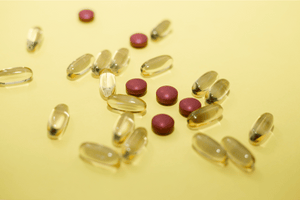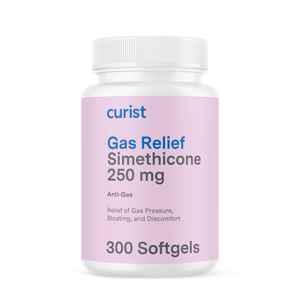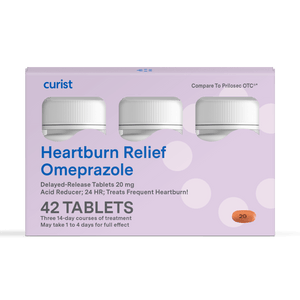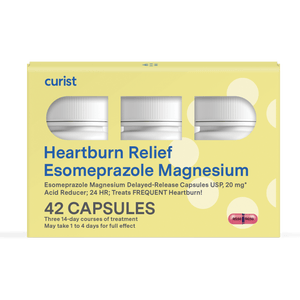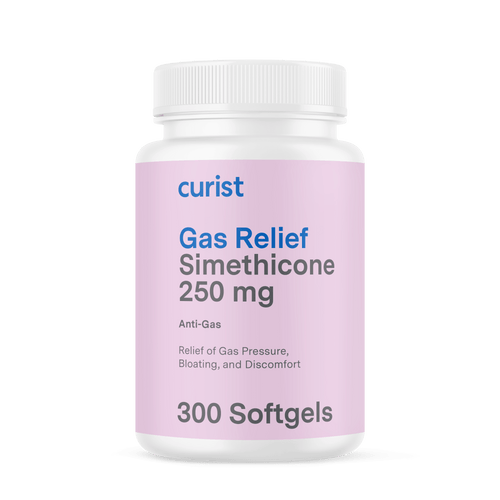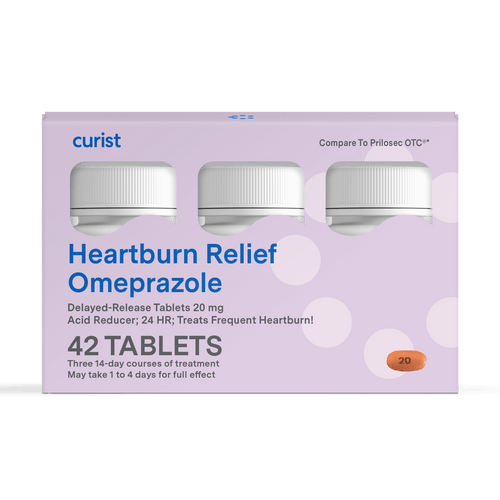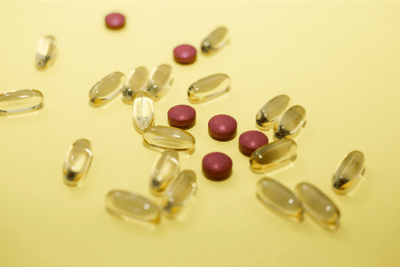Curist delivers over-the-counter medicines to your door at a fraction of the price of traditional brands. We hope everyone stays safe and healthy during this time.
What is Gas Pain? What are the Symptoms of Gas Pain?
Gas pain occurs when gas is trapped or not moving well through your digestive system. You may feel uncomfortably full and your stomach may look swollen. Gas is a normal part of the digestive system. Our body typically gets rid of excess gas, either by burping or passing gas. There are three main gas-related complaints:
- Excessive belching
- Bloating
- Excessively passing gas
Gas pain can be due to various causes like certain foods (e.g. lentils, dairy, and foods high in sugar) or swallowing too much air. Symptoms of gas pain may include abdominal pain, stomach cramps, or a knotted feeling in your abdomen. You may also experience more burping, passing gas, and uncomfortable bloating.
How Do I Know if I Have Constipation or Gas Pain?
Depending on certain symptoms you may have constipation or gas pain. If you have difficulty passing stool or have gone more than 3 days without a bowel movement, you may be constipated. Other symptoms of constipation may include passing hard, dry, small stools and feeling like you can not fully empty your bowels.If you feel bloated or uncomfortably full, and excessive belching or excessively passing gas, you may have excess gas. If you have these symptoms and feel pain and discomfort you may be having gas pain.
Are Gas-X, Phazyme, Mylanta and Mylicon the Same Thing?
No, Gas-X, Phazyme, Mylanta and Mylicon are not the same thing. The active ingredient for both Gas-X and Phazyme is simethicone, though the products may contain different strengths of simethicone. Phazyme products are typically available at higher strengths (up to simethicone 500 mg) than those of Gas-X (up to simethicone 250 mg). To learn more about simethicone, check out the Curist article Simethicone FAQ.
Similar to Gas-X and Phazyme, Mylanta contains simethicone but also contains aluminum hydroxide and magnesium hydroxide. So not only does Mylanta work to relieve gas, it has an antacid to relieve immediate heartburn. Unlike Gas-X and Phazyme, Mylanta is also available in a liquid form.
Mylicon is different from Gas-X, Phazyme and Mylanta with regards to who can use the product. While Mylicon also contains the active ingredient simethicone, Mylicon is used specifically for infants. Mylicon contains a lower dosage of simethicone, typically simethicone 20 mg as infants only need a small amount of simethicone to gently break down their gas bubbles and relieve gas pain.
What are the Differences Between Gas-X vs Phazyme vs Mylanta vs Mylicon?
Gas-X, Phazyme, Mylanta, and Mylicon mainly differ in their active ingredients, formulation, target population, and side effects. Continue reading to learn more about their exact differences.
Phazyme vs Gas-X vs Mylanta vs Mylicon: Active Ingredients
Gas-X, Phayzme, Myltanta, Mylicon all include simethicone as an active ingredient, but at different strengths and potentially alongside other active ingredients.
- Gas-X: Simethicone (125 mg, 180 mg, 250 mg)
- Phazyme: Simethicone (180 mg, 250 mg, and 500 mg)
- Mylanta: Aluminum hydroxide (400 or 800 mg), magnesium hydroxide (400 or 800 mg), and simethicone (40 or 80 mg)
- Mylicon: Simethicone (20 mg/0.3 mL drops)
Gas-X vs Mylicon vs Mylanta vs Phazyme: Dosage Form
Even though Gas-X, Phazyme, Mylanta, and Mylicon all contain simethicone, they come in different dosage forms.
- Gas-X: Available as chewable tablets and softgels
- Phazyme: Available as chewable tablets and softgel
- Mylanta: Available as chewable tablets and liquid (can be given as drops as well)
- Mylicon: Available as drops and chewable tablets
Gas-X vs Mylanta vs Mylicon vs Phazyme: Adult vs Infants
- Adults: Can use any one of the following: Gas-X and Phazyme or Mylanta
- Infants: ONLY Mylicon
Gas-X vs Mylanta vs Mylicon vs Phazyme: Pregnancy and Lactation
Simethicone is considered safe for pregnant or nursing women. It is always encouraged for you to consult with their doctor first before taking any kind of medications especially with pregnancy or lactation.
Gas-X vs Mylanta vs Mylicon vs Phazyme: Side Effects:
Gas-X, Phazyme, Mylanta and Mylicon are generally well-tolerated. If you ever experience any severe reactions such as rash, itching/swelling of face, tongue or throat, trouble breathing, or severe dizziness while taking this medication, seek medical attention immediately.
For simethicone 250 mg, check out Curist Gas Relief which is available at a fraction of the price of brands like Gas-X and Phazyme.
Which Works Better for Gas Pain and Bloating: Gas-X vs Mylicon vs Phazyme vs Mylanta?
The product that works best for gas pain and bloating depends on the type of person using and the extent of their gas pain or bloating. If you feel severe gas pain and bloating, Phazyme is recommended as it is available in higher and stronger strengths than Gas-X. If you have occasional gas pain, bloating, and heartburn, Mylanta may work better for you as it can provide both immediate heartburn and gas pain relief. Mylicon is indicated for infants only as it comes in a much lower strength (20 mg/0.3 mL) and is typically recommended by pediatricians to help relieve gas pain and bloating in infants.
What is the Difference between Gas-X, Mylanta, Mylicon vs Simethicone?
Gas-X, Mylanta, Phazyme and Mylicon are all considered effective medications for the treatment of gas pain. They all contain the same active ingredient, simethicone, but differ in the amount or strength of simethicone in each product.
Can You Take Any of These Medicines Together: Gas-X, Mylanta, Phazyme and Mylicon?
Typically, it is not recommended to take any of Gas-X, Mylanta, Phazyme and Mylicon together as they all contain the same active ingredient, simethicone. Taking these products together could lead to an overdose of simethicone. One exception is that you may use Mylanta with Gas-X or Phazyme because Mylanta contains little simethicone.
Consider starting off with Gas-X and if your gas pain and bloating does not resolve, then consider switching to Phazyme and at the higher strengths. Keep in mind that an adult’s total daily amount of simethicone should not exceed 500 mg. If you feel like your symptoms are not resolved with the daily max dose of 500 mg simethicone, consult with a healthcare provider or a local pharmacist to determine what’s best for you at that point.
Mylicon should not be used together with Gas-X, Mylanta, Phazyme because it is specifically indicated for infants, and using these other agents together could potentially be harmful to infants.
For simethicone 250 mg, check out Curist Gas Relief which is available at a fraction of the price of brands like Gas-X and Phazyme.

